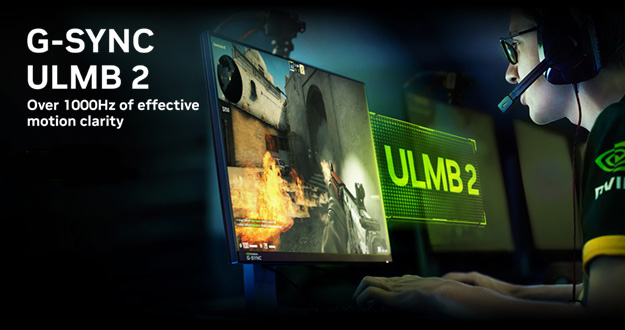
Nvidia recently announced its second generation Ultra Low Motion Blur (ULMB) technology, dubbed ULMB 2. This update massively improves the technology’s capabilities on high-refresh rate monitors, enabling nearly 2x greater brightness than its predecessor and motion blur quality that is nearly 4x greater than current 360Hz monitors — rivaling theoretical 1000 Hz to 1400 Hz monitors if they existed. A couple of ULMB 2 compatible monitors are already on the market today, thanks to a firmware update, but more will be coming in the future.
ULMB 2 will allow gamers to more quickly prioritize and accurately target enemies with a large boost in motion blur quality. With ULMB 2 active, monitor-based motion blur is effectively deleted, giving gamers excellent object recognition no matter how fast an enemy or object is moving on the screen. It doesn’t boost the monitor’s response time outright, but ULMB 2 substantially increases the monitor's image quality at the same refresh rate it ships with.
To achieve the same level of “blurless” motion quality on a non-ULMB 2 panel, panel manufacturers would need to create a gaming monitor featuring a refresh rate in excess of 1000 Hz, and a refresh rate of 1400 Hz to compete with a 360Hz gaming monitor using ULMB 2 technology.
Nvidia’s original ULMB 2 technology works, by strategically enabling the backlight on an LCD panel only when needed to generate the best-looking image. Traditional monitors keep the backlight enabled continuously allowing users to see crosstalk a display generates as the pixels are changing colors. ULMB on the other hand, turns off the LCD backlight completely as the pixels are changing colors and only turns it back on when all the pixels are done transitioning to their new colors. As a result, ULMB reduces artifacts such as crosstalk or display-driven motion blur and produces a clearer image.
On top of this, ULMB 2 also tweaks the pixel response time in conjunction with G-SYNC technology to improve the accuracy of backlight engagement right as the pixels are done switching to their new colors. This means that the LCD backlight has more opportunity to be enabled at the right time since the pixel response time can be increased (overdriven) or decreased if needed.
Compared to Nvidia’s original ULMB tech from 2015, ULMB 2 is a massive upgrade due to the fact it supports backlight strobing (turning the backlight on and off), at a display’s native refresh rate. This wasn’t the case with its predecessor, due to the limitations of gaming display hardware back in 2015. Pixel response times were so slow, that the display refresh rate had to be reduced in order for ULMB to be effective. Thanks to an almost 10-year gap in monitor technology, Nvidia is able to run ULMB 2 at a monitor’s maximum refresh rate, massively improving brightness, and giving the tech its 1000 Hz to 1400 Hz-like quality.
For now, only two monitors support ULMB 2 with the addition of a firmware update, those being the Acer Predator XB273U F 27-inch 1440p 360 Hz monitor and the Asus ROG Swift PG27AQN 27-inch 1440P 360 Hz monitor. However, Nvidia says more ULMB 2 monitors are on the way, including the new ASUS ROG Swift Pro PG 248QP 25-inch, 1080p 540 Hz monitor and the AOC Agon AG276QSG 27-inch, 1440p 360Hz monitor which will be available soon.







